-
THE FAITHFUL: THE KING, THE POPE, THE PRINCESS (Annie Berman 2021)
ANNIE BERMAN: THE FAITHFUL: THE KING, THE POPE, THE PRINCESS (2021)
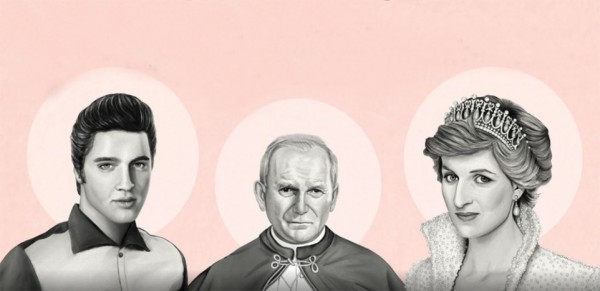
Long-pursued film about obsessive fandom becomes its own obsession
Annie Berman, the film's maker and constant intimate narrator, says she is exploring the origins of celebrity; her narration is designed to link together videotapes she shot over twenty-plus years. There is a wealth of material here, maybe too much. She claims a lollipop in Rome with the Pope's face on it (which we see) leads her to go to Memphis to learn about Elvis. She can't take a camera into Graceland but she is allowed into a nearby related house (he lived there early on) occupied by a big Elvis fan who has a sign outside saying "Elvis Fans - Make Me an Offer," so apparently if you pay something, you get a private tour, and she films her visit to the memento-packed rooms. Twenty-three years after Elvis' death she visits here and goes to the night service in honor of his demise with 15,000 people carrying candles.
Then she returns to the Vatican to trace back those "origins." On another jaunt, she is on hand only a few years after Lady Diana's death to tape the worshipers. Then back to Elvis again, over and over. A confessional element enters. Director Berman's obsession with shooting pieces of her film, which goes on for decades, leads to her fiancee's departure, upon which her mother thinks she needs help. She indeed sees a shrink, she tells us. She shows the rows and rows of small "Elvis," "Pope," and Diana tapes she has filed, dozens of them. It seems a little like the fanatical Elvis, Di, or Pope fetishists' collections of memorabilia she has filmed, though perhaps more tidy. "Pope Tape 46," "47," and so on are shot in Canada at what is dubbed "Popestock," a massive gathering in the rain and mud for a visit from the Pope.
Berman's fascination with making all these tapes begins to seem hermetic and self-obsessed. But after years she says she stops looking for anything and starts finding interesting things, such as an Elvis cover band found by chance at a bar in Rome, the Pope's town. She understands Italian (we don't know why) and we hear from one of the people outside the bar, in Italian, about how she became an Elvis fan: she was orphaned at the age of nine, and was lonely. Askew, away from the central obsessions, the film finally seems to breathe a little - and to find a basic explanation for Elvis-mania - perhaps also Pope-mania and Diana-mania?): a void we all have in the soul and a deep need to fill it.
Berman is drawn to photographer Ralph Burns who's a friend now and who has been doing Elvis-fan-related photographs for 40 years, still working with film and developing it by hand, which she seems to like and may envy the hands-on quality of. He is searching for some will'o'the wisp of ultimate meaning in Elvis worship - or maybe just a good photograph?
It might be unfair to suggest that Berman's search for "the origins of celebrity" is based on too limited a sample in her focus on only three celebrities, be they big ones, or that her voiceover is narcissistic. One wonders if she's right that being Jewish gives her an "outsider" outlook on these fandoms. Maybe she's just an "outsider" because she's not so silly, for are not these groupies silly people? And aren't we all outsiders when observing collective phenomena like these?)
Berman's incessant, lulling narration is a sign the film's images themselves are never interesting enough. This is a kind of documentary one has seen before: one that's overworked, to diminishing returns, a self-absorbed nonfiction project in which the filmmaker got stuck in a groove for a long time and couldn't get out, couldn't stop, and went on shooting even though nothing much new was coming. Celebrity-worship is in itself a form of excess, so, in studying it, how do you know when too much is enough? Typically, this film just sort of ends.
This is about materialism though, and outsiders looking for a common bond, and it is a record of Felliniesque Mondocane absurdities like Pope-face lollipops (officially licensed, but you may not lick the Pope's face!). And it is true that Berman never becomes snide, always remains sympathetic, and the message about love and loneliness and worship, grieving and memory, therefore is personal, honest, and kind.
(A review by Mick LaSalle in the Chronicle shows that this film was already shown in the city - at the independent cinema the Roxie - and reviewed nine months ago.)
The Faithful: The King, the Pope, the Princess, 91 mins., premiered in NYC Aug. 13, 2021 and Memphis Aug. 14, 2021., showing at Camden Oct. 2021; limited release Oct. 2021. Screened for this review as part of the San Francisco Jewish Film Festival, where it showed July 25, 2022 at the Castro Theater with the filmmaker, JFI Filmmaker in Residence, present.
Last edited by Chris Knipp; 07-26-2022 at 11:20 PM.
-
THE CROSSING/LA TRAVERSÉE ( Florence Mialhe 2021)
FLORENCE MIALHE: THE CROSSING/LA TRAVERSÉE (2021)
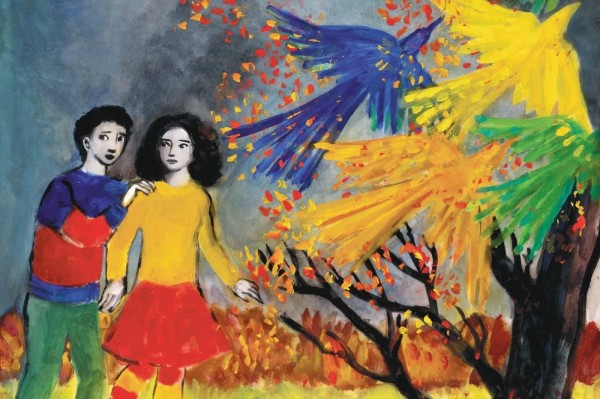
BROTHER AND SISTER ADRIEL AND KYONA IN THE CROSSING
Hand-painted animation of a wartime flight delights with its visuals even when the story doesn't
This fictional animated film features surreal and fairytale-like imagery that evokes brush drawings and paintings, thanks to the distinctive technique of filming oil paintings on glass. Comparisons have been made with Loving Vincent, but that is an animation of Van Gogh paintings, and this is the work of one person, though the style, a mixture, is reminiscent of several modern artists, even Dufy and Picasso, perhaps Chagall, perhaps Matisse, perhaps Van Gogh. It's hard to pin down, but feels classic, and often delights with its fluid line and radiant color.
What most satisfies here is not the storytelling. The language is standard, simple French, and that's pleasant. But the action of the siblings fleeing a pogrom through many vicissitudes to cross into another land ultimately disappoints, and it's hard to say exactly why. The story, cowritten with Arnaud Desplechin's sister Marie, is referring to Mialhe's mother and grandmother, but inventing names, people, and places that are not a direct reference to any place or people we have ever known. Some of the events resemble Jerzy Kosinski's The Painted Bird, or Vaclav Václav Marhoul's 2019 film version of it, and we know a lot of that was invented, but it was more detailed and specific. Here Mailhe never quite finds the sweet spot between the mythical and the historical that she is seeking. but it doesn't matter too much, because the visuals are rare and beautiful.
What appeals are the hand drawn animations, though they're not uniformly great. Linear closeups of the two siblings, which are that, very linear, are very pleasing. So are scenes that are more complex, when she turns to a bright palette; the dark scenes tend to be muddy. Above all we share her delight in the look of brush strokes on glass, brush strokes one can see into. The older sister Kyona is an artist, and she is continually flipping through her drawing book. Somehow she manages to hang onto it. It is a delight to look at the pages as they turn. It is a little as if we are looking at the drawings being drawn, the film being made.
Mialhe is best at broad-brush line drawings, and those are what are celebrated in all those flips through the drawing book. The way Kyona and Adriel's faces are drawn is beautiful, Jewish, and classic, beautifully Jewish. Those images are a celebration of Jewishness - whereas it's not otherwise emphasized that their situation is unique. And that is a trouble - it's not clearly enough pinpointed.
Given the simple language, the fairytale details, and the focus on two young siblings, this seems like a readymade film for children, but as a French review said, due to the harshness of the story, it's hard to see it as suitable for those under 12.
The Crossing/La traversée, 84 mins., debuted at Annecy, the major animation festival, Jun. 2021, showing Sept. at an Sebastián, and subsequently at numerous other festivals. Screened for this review as part of the San Francisco Jewish Film Festival in July, 2022.
Schedule
Tuesday July 26, 2022
3:15 p.m.
Albany Twin
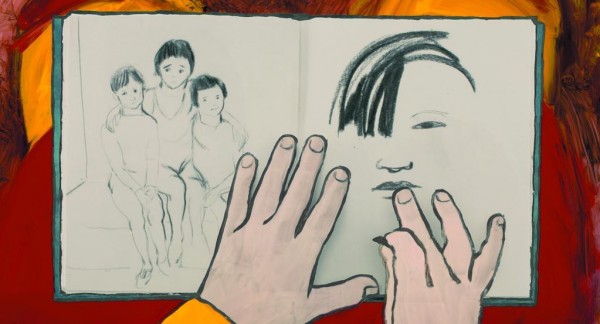
KYONA'S SKETCHBOOK IN THE CROSSING
Last edited by Chris Knipp; 07-26-2022 at 11:53 PM.
-
SUMMER NIGHTS (Ohad Milstein 2021)
OHAD MILSTEIN: SUMMER NIGHTS (2021)
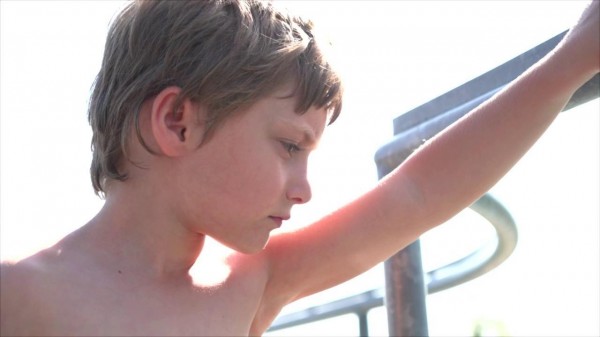
ALVA IN SUMMER NIGHTS
A prize-winning Israeli documentary in which a father explores the point of view of his six-year-old son, with reference to his own father
Hate to be a complainer but the only thing that's wrong with this little documentary is that it's too perfect. The filmmaker Ohad Milstein creates wonderful purity where nothing unnecessary intervenes. But this truly, clearly, is a very safe environment for the six-year-old Alva. This is a picture of six-year-old Alva, an Israeli boy who speaks Hebrew to his father and grandfather and French to his Swiss mother. The film witnesses moments in Alva's life in the summer before he goes off to his first school.
This is a prize-winning short film and so it is well constructed. The shape comes from moments: Alva asking his father about aging and, by implication (but skirted), death. A haircut by the father for the boy and similarly one by the father for his own father, who is less satisfied. Alva dancing in colorful tights; swimming; standing on a high diving board; running. In a whispered voiceover he talks about his fear of heights, but he comes off as graceful, athletic, physically well developed for his age. During an interlude in Bern, Switzerland, he also woos a girl his own age - without much luck, though. He offers her white chocolate which she won't take. "It's chocolate!" he says. Enough said.
Actually this may be more than anything about Ohad, the father's, relationship with his son. Hence also it takes time for Ohad to talk to his father, at first portly but athletic on the beach, discussing whether they ever had searching conversations when Ohad was small, as Ohad is having with Alva. That these conversations, because at night, are whispered not to awaken his little sister, makes them seem all the more magical. They did not have such conversations, or almost never. So we have the old theme of the son who tries to have with his son the intimacy and love he didn't have with his own father. Those magical whispered conversations between Alva and Ohad do contain declarations of love, and promises always to be there to help and support, to hug and kiss, but Alva decides he will do this, the hugging and kissing of his father, till he's 35, and no longer.
Time spent by Alva with his mother, in French, is spent more talking about school, assembling colored pencils, and a pencil case that delights Alva. It's as if French is for practical academic matters and courtship, while Hebrew (as is only fitting?) is for talking about love and death, God and the passage of time. "Do you believe in God, dad?" Alva asks. There is a nice irony in the way Ohad and his father discuss whether he should tell Alva the truth and he says yes, and not to say the stork brings babies, and then near the end when Alva asks where babies come from his father says the stork brings them, and Alva, saying "What stork, father?" seems to know that's a silly fiction.
A further development of the sub-theme of the grandfather is said elder's keeping his father's photo in a drawer all these years, and, chided by a discussion with Ohad, bringing it out to frame and hang on his wall at last. He, son and grandson and nephew of carpenters, he says, tries to make a frame for his father's photo helped by Alva, and badly botches the job. He takes the photo to a framer, and hangs the framed photo as we watch (i's dotted, t's crossed). But the mess of a job becomes a subject of joyous laughter for granddad and Alva. There is no shame, no pain; acceptance.
I probably long for a touch of imperfection, a moment of real awkwardness or tears. But this is simply a perfect film about a perfect boy, and a perfect age of curiosity, purity, and sweetness - and readiness to love. The neat shape of the film is that it's a long recollection about a summer. It reminds one of a more perfect, more complex film about the same age, or ages close to Alva's, Nicholas Philibert's amazing 2002 documentary about a French mountain country elementary school with a single dedicated teacher, To Be and to Have/Être et avoir. Where this film ends, that one begins.
Summer Nights, 53 mins., debuted Jul. 2, 2021 at Tel Aviv's Docaviv festival, where it won a best film award; also shown at Bologna Biografilm Festival. Screened for this review as part of the San Francisco Jewish Film Festival, July 21-Aug. 7, 2022.
Schedule
Thursday July 28, 2022
6:00 p.m.
Albany Twin
Last edited by Chris Knipp; 07-27-2022 at 05:54 PM.
-
THE RESTLESS HUNGARIAN (Tom Weidlinger 2021)
TOM WEIDLINGER: THE RESTLESS HUNGARIAN (2021)

PAUL WEIDLINGER (RIGHT) IN THE RESTLESS HUNGARIAN
TRAILER
Weidlinger's exploration of his father is detailed yet unsatisfying
This film is based on Tom Weidlinger's book exploring the life and work of his father, The Restless Hungarian: Modernism, Madness, and the American Dream (2019). The film makes one think of Nathanial Kahn's wonderful Oscar-nominated My Architect: A Son's Journey,(2003) . Two great, distant fathers in the field of architecture, pursued in documentary films by their sons. But the latter is more successful and more moving as a film. Louis Kahn was a truly great architect, the son's filmmaking pursuit of him is touching and real, and the end of his film explores his father's monumental, transcendent work and finishes on a note of exultation, even joy. And Nathanial was illegitimate, the fruit of another, secret union. Whatever we may think of him as a man, Louis Kahn inspires awe as an architect, an artist: we can feel happy that Nathanial was able to connect with him in this beautiful way. Tom Weidlinger is doing something different, exhaustively exploring his father's life, connections, secrets, and his father Paul, though Tom says he is "famous," is certainly significant and highly accomplished but his life lacks that significant shape of pursuing a unique artistic vision. And while his son wants to admire him he has reason not to like him. Paul Weidlinger was a cold, difficult man who pursued some dubious projects, working for decades on designs for protective silos for nuclear missiles that were never built, while part of the Rand Corporation, which Daniel Ellsberg, once allied with it himself, describes as a "doomsday cult" in an interview for this film.
In fact Paul Weidlinger seems to have gone wrong several times. The first surprise discovery for Tom is that his father was Jewish, though I'm not sure exactly how this could have escaped his son. But this is something that happened sometimes: that Jews who had a horrible time escaping the Nazis chose to conceal their Jewishness thereafter. It seems a mistake that Paul left Bolivia, where he and his French Swiss wife Madeleine found refuge, or he did and she joined him (she was not Jewish; she was just going to become schizophrenic). He was so happy and successful there, as the film tells it, and instantly rich because qualified engineers were so in demand. Instead he chose to immigrate to the US, where he became the structural engineer for buildings designed by some major architects and major sculptures by Picasso and Dubuffet (it's appealing that he had a penchant for Dubuffet and was part of the Bauhaus). At some point Madeleine manifested her schizophrenia unmistakably and went into a clinic so expansive Paul had to found a business to raise the money to pay for her treatment there. They gave Madeleine insulin and electric shock treatments that she said were horrible. Maybe if he had not decided to marry her before he had even met her, he might have chosen more wisely.
Another mistake is that he seriously discounted Tom's older sister, Michelle, who later killed herself and her young child, for which Paul held himself responsible, as he says in an earlier filmed interview by Tom made when in his eighties, excerpted here. When Tom was born Paul was delighted to have a son, and made her insignificance obvious to Michelle. But since Tom tells of being suicidal at several times, including quite recently, his relative favor may not have greatly benefitted him. He seems to have been aware of his father's doomsday nuclear activities at a time when he was a longhaired youth listening to Bob Dylan's "Masters of War."
But while Paul Weidlinger's life as explored here is an unsatisfying mixture, the film is nonetheless a review of a large slice of the twentieth century. And as if to compensate for its subject's failings, and as befits a filmmaker who has numerous docs under his belt, re[s a rich and often entertaining amalgam of documents, some of them shot by Madeleine, who early on always had a Leica in hand, and seems to have shot film footage of the family as well, though those are mostly reenactments shot by Tom. Reenactments always fill one with misgivings and uncertainty, but one can't say they're not well done.
Paul's early life is dramatic and fascinating: his upper middle class origins, mixed success at school, his communist activity, leading to a barely escaped death sentence; his identification with the Bauhaus; then his struggle to live through the thirties as a Jew and escape the war. And then Bolivia, with Tom's vivid recreation of the ocean voyage there amid a great crowd of interesting, very lucky refugees who are going to escape the war and the Holocaust. But in the end, though Tom Weidlinger has pursued his father so energetically, we are left depressed by the downers of the personal life and disappointed by the rather slapdash review of Paul's biggest projects - the contrast is so clear with the lingering, noble visit to Louis Kahn’s Sher-e-Bangla Nagar, Dhaka, Bangladesh buildings at the end of Nathanial Kahn's My Architect.
The Restless Hungarian, 105 mins., was screened for this review as part of the San Francisco Jewish Film Festival, July 15-Aug. 7, 2022.
Schedule
Friday July 29, 2022
3:05 p.m.
Albany Twin
Last edited by Chris Knipp; 07-29-2022 at 12:00 AM.
-
TAKE THE 'A' TRAIN (Yair Asher, Itamar Lapid 2021)
YAIR ASHER, ITAMAR LAPID: TAKE THE 'A' TRAIN (2021)
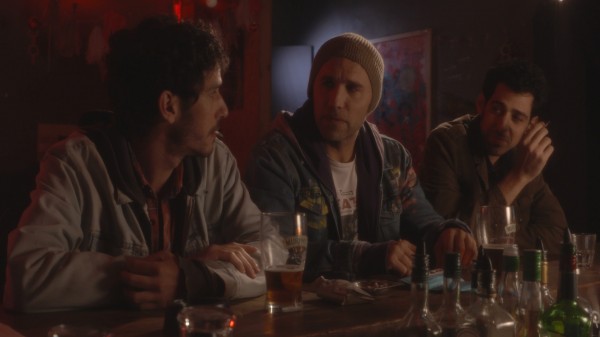
YUVAL ORON, LEFT, AND YAKIR PORTAL, RIGHT, IN TAKE THE 'A' TRAIN
A vivid look at Israel's current generation of late-twenties, early-thirties urban slackers.
The focus is on Yishai (Yakir Portal), a jazz pianist who now lives in Paris (with classical chops, which he shows off) who suddenly turns up back in his native Tel Aviv, reconnecting with his middle-class parents who live there, his leftist dad (Alon Olearchik) and young-looking, loving mother (Anat Atzmon), and with his slacker younger brother Omer (Yuval Oron). The two tall, long-faced young men look almost like twins. They both play basketball, party, drink, smoke, listen to recorded music, make out with women who leave early, party all night. What's up? Directors Asher and Lapid seem more into atmosphere than story. They know their milieu, the film is appropriately cast, the sometimes shaky handheld camera is fluid. Tech specs are minimal, story arc rambling; this will appeal to those whom it's about, and may leave others cold. It is not a happy picture of the coming generation of Israeli adults.
Yishai's situation back in Paris remains rather mysterious. He has a group and gigs waiting for him thre. He talks to a bandmate, a girlfriend or ex, not exactly saying where he is. What there is comes through the interaction of Yeshai and Omer. The parents are concerned that Omer has dropped out of university, which he says is a bunch of has-been oldsters (he seems not to have connected with the students). His pals are partly musicians too, so Yishai connects with them; he also connects with women he knows, and an old girlfriend, who is free and horny, but has a horrible roommate she has gotten stuck with who plays his music so loud they can't have sex. They drive to a bad part of town; she rejects his suggestion of a hotel room as too expensive. But their effort at car sex is thwarted by a creepy peeper.
In one scene Yishai has persuaded Omer to come to have dinner at their parents' with some older adults. A hot debate over politics breaks out: this is no easygoing social event. Omer gets into a verbal fight with their parents and leaves before their mother brings desert, but we see them driving together next; another party.
Yishai interacts with Omer's mates, one of whom is on the verge of a breakup. There is a fight over a new leather sofa. Yishai proposes that Omer come to Paris with him and share his flat, saying he can stay a long time, it will be easy to get a job, it will be great. Omer suggests to a girl at a party that she go to Guatemala with him. She says she can't: she's just gotten a job.
At the end of this film there is some suspense because the brothers seem so impulsive and lacking in interiority or clear committment we do not know if Omer will go to Paris or Yishai, who has said his return flight is tomorrow, will for some reason decide to stay in Tel Aviv and give up the life in Paris he keeps saying is fine (maybe it isn't?). At the end, Omer drives Yishai to the station at 6 a.m. to catch the train to the airport. We leave them sitting there by the track as the train is apparently about to arrive. The uncertainty remains, though this is hardly a storytelling coup. Yair Asher and Itamar Lapid seem even at the end ready to tell a story but not to have begun it yet. It's in the station, but the train hasn't come yet. Nadav Lapid or Samuel Maoz these directors are not. But they presumably represent a younger generation and will have new things to say.
Take the 'A' Train, 103 mins., debuted at Jerusalem Aug. 2021 (nominated for a best feature award). Screened for this review as part of the San Francisco Jewish Film Festival of July 15-Aug. 7, 2022.
Schedule
Friday July 29, 2022
8:45 p.m.
Albany Twin, Albany CA
Last edited by Chris Knipp; 07-31-2022 at 09:49 AM.
-
SIMCHAS AND SORROWS ( Genevieve Adams 2022)
GENEVIEVE ADAMS: SIMCHAS AND SORROWS (2022)
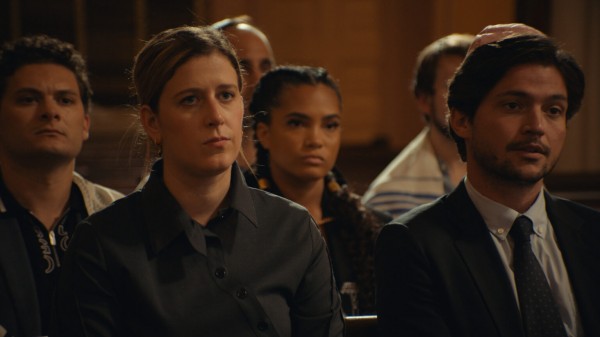
GENEVIEVE ADAMS, THOMAS MCDONELL IN SIMMCHAS AND SORROWS
In an ambitious directorial debut, Genevieve Adams references her own experience of marriage into a Jewish family
Genevieve Adams has made a semi-autobiographical film about Agnes (writer-director Genevieve Adams), a young pregnant Catholic-raised, now atheist woman who, with her fiancee Levi (Thomas McDonell), enrolls in a Judaism class taught by progressive, feminist Rabbi Cohen (Hari Nef, "Assassination Nation") in order to convert to his faith and satisfy his family. Adams went through something like this experience herself, and evidently came through it happily. Her film is humorous, but never bitter, even if the humor doesn't always come off. Agnes' family is represented here through a grandfather who raised her, played by 92-year-old two-time Tony winner John Cullum. Adams had no trouble playing pregnant since she was.
Adams, who is relaxed, and McDonell, who is good humored, are fine in every scene where they're together enacting their sometimes conflictual relationship (celebrating Christmas as an ethnic holiday becomes a sticking point). Some of the times in the rest of this movie are less successful. The setting is Williamsburg, Brooklyn and Manhattan and not for the first time I thought of the great HBO series "High Maintenance," whose scenes and locations are similar, and wished for some of that wit, specificity, and lightness of touch.
Agnes teaches a class for little kids. Having them talk like sophisticated adults have worked if children had been found who could recite such lines convincingly and understandably. Scenes with Cullum as the grandfather and Broadway vet Chip Zien as Agnes' prospective father-in-law ought to have flowed more seamlessly and with a surer tone.
Obviously there are simply flaws in Genevieve Adams's writing, which is rife with non-sequitur and overly explanatory moments; and in her direction and the editing;, which don't always find a smooth rhythm. This issue is notable in the Judaism class where neither the writing nor the delivery of Hari Nef as the rabbi feels quite right. Trimming would have helped the script.
But one supposes those who identify with this experience or are looking for a way to relate to it may find moments of satisfaction.
Simchas and Sorrows, 117 mins., debuted at Cinequest (San Jose/Redwood City) Apr. 7, 2022, and was screened for this review as part of the San Francisco Jewish Film Festival (July 15-August 7, 2022). The film was shown Fri., Jul. 22, 2022, 5:30 pm at the Castro Theater.
Last edited by Chris Knipp; 07-31-2022 at 09:23 AM.
-
REPAIRING THE WORLD: STORIES FROM THE TREE OF LIFE (Patrice O'Neill 2022)
PATRICE O'NEILL: REPAIRING THE WORLD: STORIES FROM THE TREE OF LIFE (2022)
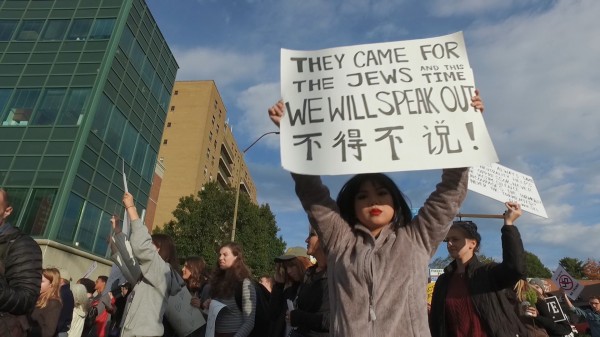
DEMONSTRATION SHOWN IN REPAIRING THE WORLD
The 2018 Pittsburgh anti-Semitic massacre: a film about community response
Pittsburgh is "small," this film says; and the city's solidarity was great after the October 27, 2018 massacre of 11 Jewish worshippers (including a 97-year-old woman) at the Tree of Life Synagogue, the worst anti-Semitic attack in US history. There was an immediate outpouring of support across communities. It may have helped that the Squirrel Hill neighborhood where this happened is a particularly friendly one. It is also one with a strong Jewish element and the city is very segregated and yet "there is a level of unity and solidarity here that there isn't in other cities", says Wasi Mohamed, then Islamic Center director, who raised close to $1/4 million to help victims. This is an energetic and dedicated documentary that represents three years of work by director Patrice O'Neill, who has previously focused on attacks of this kind in her films. Here especially there has been a coming together. The ongoing collective action chronicled in O'Neill's film is a dramatic, wide and touching interpretation of the Jewish concept of "tikkun olam," repairing the world.
The accused (unnamed here, who pleaded not guilty and is still awaiting trial) is a white supremacist. This movement has grown greatly in recent years; clearly, Donald Trump tacitly supported it (and still does). Hence the new connection of the Black community with the Jewish community, also the Muslim community - great multi-ethnic, multi-religion unity developed.
But: there are white suprematists in Pittsburgh, and their threats nation-wide have abounded. Always they increase after a major incident like the Tree of Life massacre. Furthermore, a wide pro-gun coalition exists throughout the country. New Pittsburgh restrictions on the use of assault weapons in the wake of the Tree of Life attack were later struck down by the court as violating Pennsylvania gun laws.
Brad Orsini, director of security for the Jewish Federation of Greater Pittsburgh; appears here as one who, through the 2018 event, came to a greater understanding of what it would be like to be a member of a minority that is an object of hate crimes.
The Poway synagogue shooting of April 27, 2019 near San Diego, California, which saw one killed and three injured, again caused a gathering of Pittsburgh community figures covered in this film. Likewise August 3, 2019, when a gunman killed 23 in a Walmart in El Paso, Texas; the shooter is one who believes there is a Hispanic invasion in Texas. as local Hispanic hate crime representative explains. This upsurge of racist and anti-Semitic violence in the US following the Tree of Life attack has brought Pittsburghers continually closer together, as the film shows. Efforts show in the film in meet-ups across sectarian lines at the community level and meetings and classes in high schools. Three years after the 2018 attack, Pittsburgh reached out to the world, hosting the Inaugural Eradicate Hate Global Summit, an international conference on hate.
A conventional film in form, this is nonetheless an impressive enough one for its coverage of trauma and community response. O'Neill has made a real effort to represent all elements of the community. Patrice O'Neill is a leader of Not in Our Town, a movement to build hate-free communities across the country.
Repairing the World: Stories from the Tree of Life, 90 mins., debuted at the Pittsburgh JFilm Festival on May 5, 2022 and won the best documentary audience award at the festival. It was screened for this review as part of the San Francisco Jewish Film Festival, July 15-August 7, 2022. West Coast Premiere.
Schedule
Sunday July 31, 2022
2:00 p.m.
Albany Twin
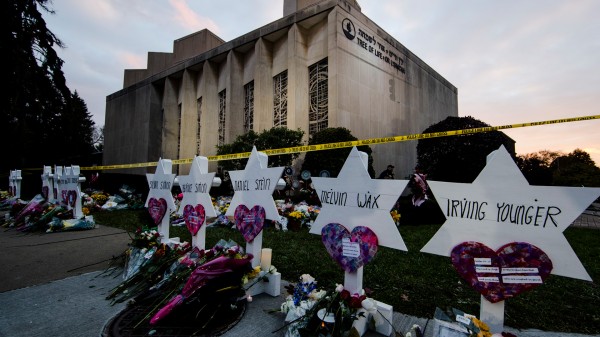
IN FRONT OF THE TREE OF LIFE SYNOGOGUE IN REPAIRING THE WORLD
Last edited by Chris Knipp; 07-31-2022 at 09:10 AM.
 Posting Permissions
Posting Permissions
- You may not post new threads
- You may not post replies
- You may not post attachments
- You may not edit your posts
-
Forum Rules





 Reply With Quote
Reply With Quote








Bookmarks